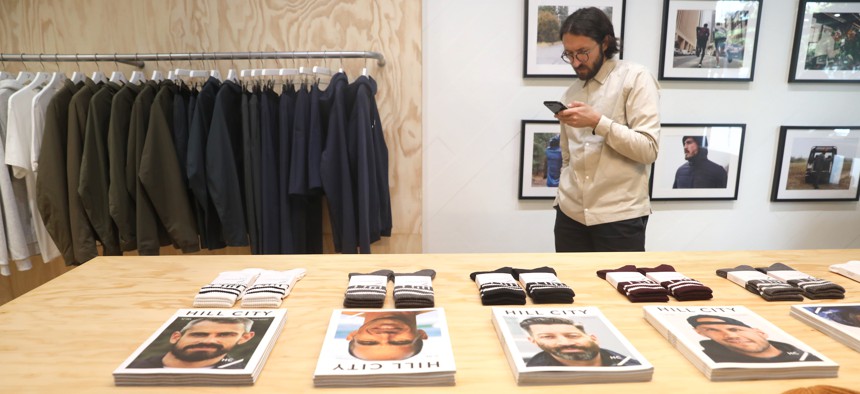A solution for dying downtowns is popping up in major cities

A menswear pop-up shop in San Francisco in 2019. Liz Hafalia/The San Francisco Chronicle via Getty Images
As business districts look for ways to revive economies weakened by long-gone office workers, cities are testing pop-up shops to reduce vacant retail space and give small business owners a launch platform.
The convenience of online shopping has taken a toll on downtowns nationwide for many years, and the pandemic only accelerated Main Street’s decline. Take San Francisco: About 30% of retail space is vacant, causing property values to plummet and raising concerns among city officials about the future of its municipal budget. A whole host of retailers—AT&T, Target, Starbucks and CVS to name a few—have recently abandoned downtown San Francisco, and other cities are seeing a similar exodus.
The declining number of downtown retail businesses has major repercussions. In the country’s biggest cities, visitors make up the largest share of people downtown on any given day, more than workers or residents, underscoring the necessity of giving people a reason to head to Main Street.
So as the largest players in the game leave downtowns, cities are looking for ways to invite small companies in. In some urban centers, that means supporting “pop-up” businesses.
Under the pop-up model, small businesses work with property owners to temporarily open a brick-and-mortar location, often for a few days or weeks, and rarely more than a few months. In San Francisco, SF New Deal, a business development nonprofit, is partnering with the city’s Office of Workforce and Economic Development to help small businesses, artists and community organizations set up shop in empty retail spaces downtown.
The program, Vacant to Vibrant, works with owners of such spaces who are willing to allow tenants to operate rent-free for at least three months. SF New Deal and the city distribute grants to cover the pop-ups’ starting operational costs, and the program also provides technical assistance with processes like permitting. The program, which is supporting 17 participants in its inaugural cohort, is part of Mayor London Breed’s Roadmap to San Francisco’s Future plan that aims to revitalize downtown.
“The hope is that over the course of the program, more residents and more community members from across the Bay Area develop a relationship with what downtown could be beyond what it is today,” said Jacob Bindman, SF New Deal’s co-founder and chief program officer.
Until recently, the heart of downtown San Francisco beat to the Monday-through-Friday, nine-to-five rhythm as office workers and the businesses that served them flooded downtown. But that reality is unlikely to return as remote work gains traction, Bindman said. That challenge, though, presents an opportunity for stakeholders to think about what they want to see in the evolving space. The new pop-up shops operate across a broad range of times and days, creating a new downtown culture that encourages foot traffic outside typical business hours.
After reviewing roughly 1,000 applicants, SF New Deal and an advisory committee ultimately selected 17 “activators,” as Bindman calls participants. Among the Vacant to Vibrant grant recipients selected to activate vacant storefronts are several artists, a few bakeries, clothing stores, an art nonprofit, a radio station and a plant store that doubles as a performance venue.
Pittsburgh is similarly hoping pop-ups will bring new life to ghostly spaces. Like San Francisco, the Steel City is trying to figure out what to do with its vacant office space. The Pittsburgh Downtown Partnership launched Project Pop-Up in August with funding to support a half dozen businesses.
The program provides rent for a storefront’s first six to 12 months, allowing businesses to test the market for their particular product without committing to leases that typically range from three to 10 years, said Cate Irvin, the partnership’s director of economic development. The “here today gone tomorrow” quality of pop-ups is a unique way to attract more foot traffic downtown, she added.
Irvin noted that the most challenging part of the program has been finding spaces that are mostly move-in ready and where landlords are willing to lease without payment. But she said there have been many engaged property owners who see the program as a long-term investment.
A pop-up gives entrepreneurs more than just a way to test whether their business is viable. “It also allows them to develop a relationship with the property owner over time, which can then hopefully develop into a good long-term relationship,” Irvin said.
Like SF New Deal, the Pittsburgh Downtown Partnership also helps pop-ups with permitting, working closely with city officials to walk pop-up business owners through municipal processes like permitting and get their questions answered quickly.
“If you have a permitting agency that's very engaged and well staffed and active, that's going to make a lot of these processes faster and smoother,” Irvin said.
Besides supporting pop-ups, the Pittsburgh Downtown Partnership is looking for other ways to bring more small businesses downtown. The organization is considering a rent abatement program for the spring that would award grants to small businesses to offset monthly payments.
In the meantime, Irvin said she’s excited to see how Project Pop-Up pans out and will keep an eye on metrics like continuation rates to shape future efforts.
“The experience in and of itself is a great opportunity to learn what works and what doesn't,” Irvin said.

NEXT STORY: States revisit wildlife management with an eye on resilience






